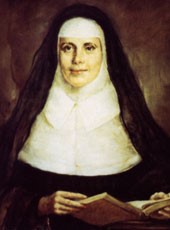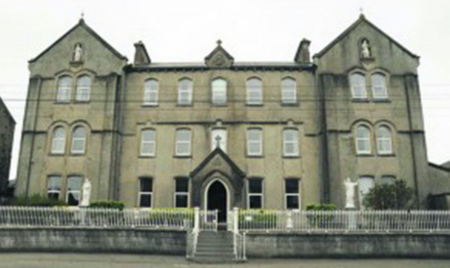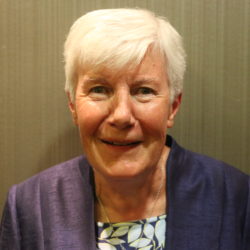Charleville, Friday 28th October, 2011
 Venerable Catherine McAuley
Venerable Catherine McAuley
On the 29th October, 1831 Venerable Catherine McAuley arrived in Charleville at the invitation of the Parish Priest, Rev. Thomas Croke and Mary Clanchy, a wealthy lady of the town. Catherine was accompanied by Mother Angela Dunne – the new Foundress – and two novices. Mary Clanchy gave a house and £500 for the foundation which she believed would benefit poor women and children.
The Sisters in Charleville celebrated the 175th anniversary of the Charleville Convent, the third house of the Order founded by Mother Catherine McAuley on Friday the 28th of October 2011. They were joined by the wider community, family members and many friends at a special concelebrated Mass in the Parish Church and later celebrated this wonderful occasion in the Park Hotel.
The liturgy was enhanced by the participation of the Primary and Post Primary school students.
Sr. Liz Murphy, Provincial Leader of the Sisters of Mercy Southern Province, preached the following homily during the Mass.
Dia Dhibh go léir. Tá athas mór orm bheith anseo anocht ag an ocaid spesialta seo. On behalf of the Sisters of Mercy in the Southern Province I greet you one and all, with special greetings on this truly historic night. There’s a famous poem, written by Clement Moore in 1823, which is often recited before Christmas that starts:
“Twas the night before Christmas when all through the house
Not a creature was stirring, not even a mouse.”
Well tonight is the night before the actual 175th anniversary of the coming of the Catherine McAuley and the Sisters of Mercy to this town, Charleville, Co Cork, way back on 29th October, 1836. We can truly say “Tis the night before Charleville!” Tonight as we gather in this Eucharistic celebration we give thanks to the God of Mercy for the continued presence of the Sisters of Mercy in Charleville for all those years.
I don’t intend keeping you too long on this rather wintry night because as Halloween beckons it’s the time we call in Celtic mythology “the thin times.” I am simply going to speak about three areas using the letters: MCC and no, I am not talking about Members of the County Council. MCC = M for Mercy, C for Catherine and C for Charleville and I also want to add the number 3 and you will see why as we go along.
M is for MERCY: Long before 1671 when Roger Boyle, Lord Broghill, First Earl of Orrery and President of Munster, asked the English King to grant the status of Chartered Borough to the town of Charleville, the God of Mercy was in this place. Long before the town of Ráth Luirc was renamed Charleville in honour of Charles I, the God of Compassion, the God of Loving Kindness was in this place. Even before Charleville railway station was founded in 1849 on the Dublin to Cork Great Southern Railway line, the God who is Alpha and Omega, the beginning and end of all time was in this place. There is more than 175 years of history when it comes to looking at the God of Mercy and Compassion. This is the God of the Old Testament who led the Israelites out of slavery in Egypt into a Promised Land. This is the God of Abraham, Isaac, Jacob and Joseph, the God of Judges and Prophets, the God of Sarah, Rebecca, Ruth, Miriam. This is the God who sent Jesus to a town called Bethlehem and who, over 2000 years ago left us a legacy to Love One Another. This same Jesus knew he was sent to bring good news to the poor, to tell prisoners that they are no longer prisoners, to tell the blind they could see, and the deaf they could hear because our God loves, and our God really loves the poor, the downtrodden, the sick, suffering and the forgotten.
This same God of Mercy was the inspiration and guide of one woman called Catherine McAuley who lived here in Ireland, and who visited this town of Charleville and brought the mercy and compassion of her God to this part of the world, this part of Ireland. Let me tell you something of the woman whose first name begins with the letter C.
Catherine McAuley was born in Dublin on 29th September, 1778 at Stormstown House. Her father James was a doctor and in today’s language he would have been known as a property speculator. Her mother, Elinor, was a social person who loved the good life. They were quite well off until her father died in 1783 leaving a widow and 3 small children. Catherine was only 5, her brother James aged 3.
Elinor died in 1798 leaving the 3 children orphaned, homeless and penniless and relatives took care of them – relatives who did not share the Catholic faith but in fact despised Catholicism. Some distant family connections, the O’Callaghan’s, took Catherine in and she lived with them for 20 years in their mansion called Coolock House. When they died they left her everything they owned. She was 44 years old at this time.
She sometimes went into the city and got to know some priests who helped her to understand God. Fr. Tom Betagh, SJ was particularly helpful.
With the money she bought some land at Baggot Street in Dublin and drew up designs for a chapel, classrooms for the children from the slums, a dormitory for the unemployed and homeless servant girls, and some small rooms for ‘ladies’ who might help her with her work.
This all became a reality in 1827 when the House of Mercy was opened. She had two friends or assistants at that time: Marianne Doyle and Catherine Byrne.
She had no intention of founding a religious congregation but people kept coming and the work prospered.
In 1829, the year of Catholic Emancipation, Dr Murray, Archbishop of Dublin challenged her to establish a religious congregation and so in 1830 Catherine, Marianne Doyle and Elizabeth Harley went to the Presentation Convent, Georges Hill to begin training in religious life and they took their vows for the first time on 12th December, 1831. That is 180 years ago!
When Catherine died aged 63 there were 150 Sisters of Mercy in 14 foundations. Today there are almost 12,000 Sisters of Mercy in every part of the world … women who have followed Catherine’s dream and Catherine’s desire to serve the poor.
What was Catherine like?
Sr. Clare Augustine Moore was an artist who saw life through the eyes or lens of an artist. This is how she described Catherine as she first saw her in 1829 (when Catherine was 51)
She was sitting in the little parlour on the right hand side of the hall as you enter. She was then upwards of 40, but looked at least 10 years younger. She was very fair, with brilliant colour on her cheeks, but still not too red. Her face was a short oval, but the contour was perfect, her lips were thin and her mouth rather wide. Her eyes were a light blue and remarkably round, with the brows and lashes colourless, but they spoke. In repose, too, they had a melancholy, beseeching look that would light up expressive of hearty fun, or if she had disapproved of anything they could tell that too. Sometimes they had a strange expression of reading you through, which made you feel that even your mind was in her power, and that you could not hide anything from her…Her hair was pale golden, very fine and silky.
Mary Catherine Maher, a niece of Fr. Edward Maher in Carlow, who entered in Carlow in 1838, also described Catherine
Mother McAuley looked about 45, though she must have been more. Her figure was rather tall, but not slight. Her countenance, though not small, was well shaped; her complexion fair, of a peachy tint; her eyes such a lovely blue as is rarely seen. She had a particularly sweet expression of sweetness and holiness that marked her entire bearing. Her voice, particularly in reading, possessed a charm not to be forgotten. Her conversation fascinated those with whom she came in contact, and such was her humility that self seemed utterly ignored.
Mother Vincent Whitty, a very close friend of Catherine’s, who nursed Catherine at the time of her death, and who brought Mercy to Brisbane in 1860, said this of Catherine some years after her death:
If you had known her, how you would have loved and venerated her, and still be familiar with her as an intimate friend. I have often wished that her lovely character could be photographed for the admiration and instruction of posterity; it seems to be that words are slow and imperfect in conveying all the lineaments of that gifted soul. She was so humble, yet dignified, so playful and witty, yet reserved and charitable, so pious and strict, yet amiable and kind. But to me at least, the climax of her attractions was that she was always the same, always ready to listen.
When Fr. Croke and Ms. Clanchy wrote to Catherine McAuley in Dublin sometime in 1836 it is now very obvious that Catherine listened. Isn’t it interesting that both the Presentation Sisters and the Irish Sisters of Charity had been invited but for one reason or another they didn’t come here!
Now I am into the other C for CHARLEVILLE:
I am indebted to Sr. Dora for her research on this and it is somewhat confusing because the accounts are hugely paradoxical.
There are two conflicting pictures of the economic conditions of Charleville in the 1830’s: On the one hand the town was prosperous – situated in The Golden Vale, surrounded by high quality land in the ownership of well-off landowners, chiefly Lord Cork. In 1824 Pigot & Co’s Provincial Directory of Ireland paints a glowing picture of the town:
The markets are excellent and the town is well furnished with good shops, for the supply of the adjacent country, as well as the inhabitants among who are many opulent residents.
In 1837 Lewis’ Topographical Dictionary, paints a similar picture of Charleville with its schools, churches and markets. Ten years later in 1846 the picture of Charleville remains much the same:
The town consists of several streets, is neat and respectable in its appearance and maintains a considerable retail trade.
But there was another side to Charleville in pre-famine times. It had a large population of extremely poor people living in hovels along laneways. A traveller at the time records seeing one such family dwelling with straw on the floor and only one iron cooking pot.
The Annals of the Sisters of Mercy at this time bear witness to this reality:
The town then had a population of about 5000 more than half of whom were illiterate and who lived on potatoes and milk in mud cabins in the back lanes.
Catherine McAuley had seen and known great poverty in Dublin and in Tullamore. This is what she heard about in Charleville. This is what drew her to Charleville. This is what brought her, together with Mother Angela Dunne and two novices – Sr. M. Joseph Delaney, and Sr. M. Elizabeth Hynes, from Dublin on the 29th October, 1836 by canal packet or barge via Tullamore.
At that time of year the journey was cold and bleak. They broke the journey in Tullamore to visit Sister Mary Ann Doyle and Sisters. However, they were not able to spend much time there because Fr. Croke had already come to meet them to accompany them on the remainder of the journey. They continued by canal packet to Limerick. It left at mid-night and did not arrive in Limerick until nine o’clock the following evening. They were cold and tired. We do not know where they stayed that night but it could have been in the Presentation Convent, Sexton Street. Next morning they went on to Charleville by stage coach and arrived there at five o’clock in the evening on the 30th October. Two days later Bishop Crotty travelled from Cobh to bless them and inaugurate Sister Mary Angela as Mother Superior.
Mary Clanchy had given one of her houses at Clanchy Terrace and a contribution of £500. The house proved uncontrollably damp and Catherine feared for the health of the Sisters. However, they immediately commenced visitation of the people living in the laneways. They prayed the thirty days of prayer morning and evening, to help them discern the will of God and obtain the strength to do it. One day as Catherine and her companion walked along a laneway, a poor woman came to her half-door and called to them “It was God himself that drove ye in among us.” On hearing this Catherine was convinced the Sisters should remain in Charleville.
For nearly four years the community numbered no more than three. Little wonder that Mother Angela Dunne tried to persuade Catherine to close the foundation. Her reply was firm “are not the poor of Charleville as dear to God as elsewhere? And while one pound of Miss Clanchy’s five hundred lasts, ought we not to persevere and confide in his providence?“
I am not going to go into the detail of all that has happened over the past 175 years. You can imagine the ups and downs, the ins and outs, the comings and goings, the women who lived here, worked endlessly here, prayed here, died here. And today, there are 16 Sisters still here … God bless them all.
However, I do want to mention how Sisters from Charleville moved out from here to places far away serving in the Crimean War in 1855. They went much closer to here e.g. to Buttevant (1879), New Inn (1879), Kilmallock (1889) Midleton (1892), They also brought Mercy to Bathurst in Australia in 1866.
One final piece before I conclude concerns the No 3: Charleville was the third house founded by Catherine. The first was Baggot Street, the second was Tullamore and the third was Charleville. In scriptural terms the no 3 always stands for what is blessed. Charleville has truly been blessed. The Herder Dictionary of Symbols says it stands for Faith/Hope/Love, for man/woman/child, it stands for Trinity in many religions. In mythology it is often the number of tests that have to be passed, the riddles to be solved. It is a symbol of Light. In the Freemasons thinking it stands for right speech, right thought and right action. I also found in another Dictionary of Symbols that the no 3 brings solution to conflict just as we see in Chapter 1 the Book of Genesis when earth and sea were separated. My favourite piece is that in truly scriptural language No 3 stands for Blessing.
 St. Joseph’s Convent of Mercy, Charleville, Co Cork
St. Joseph’s Convent of Mercy, Charleville, Co Cork
Tonight, as a little memorial of this great occasion, the Provincial Leadership Team has designed a Bookmark to mark the occasion and as we know from Friday nights and the Late Late Show “there is one for everyone in the audience” and if you haven’t got one already you will receive one on the way out.
Tonight also the Provincial Leadership of the Southern Province would like to honour this foundation here in Charleville by offering an opportunity for 4 people to visit Baggot Street in Dublin for one of the programmes there called Come Home to Catherine. Catherine came here with Mother Angela Dunne, Sr. Joseph Delaney and Sr. Elizabeth Hynes – four women came by canal from Dublin in 1836. Now we would like four women to go from the parish of Charleville back to Dublin. The programmes we have in mind are held in June and August 2012. It’s a 6 day programme of walking in the footsteps of Catherine, reflecting on her life and the heritage that has been preserved over the years. The course is residential and we will cover the travel to and from Dublin and the full cost of the programme. If you are interested please talk to any of the Sisters here in Charleville and the rest, as we say, will be history.
Finally, tonight, in the words of John O’Donohue I pray a blessing on all here present, on all who have ever lived in Charleville, Buttevant, New Inn, Middleton, Bathurst …on all the celebrants of our Eucharist, on the choir, on our families and our friends….
A BLESSING (John O’Donohue: Eternal Echoes: Exploring our Hunger to Belong)
May you be blessed in the holy names of those who carry our pain up the mountains of transfiguration.
May you know tender shelter and healing blessing when you are called to stand in the place of pain.
May the places of darkness within you be surprised by light.
May you be granted the wisdom to avoid false resistance and when suffering knocks on the door of your life, may you be able to glimpse its hidden gift.
May you be able to see the fruits of suffering.
May memory bless and shelter you with the hard-earned light of past travail, may this give you confidence and trust.
May a window of light always surprise you,
May the grace of transfiguration heal your wounds.
May you know that even though the storm might rage
Not a hair of your head will be harmed.
On Saturday, 29th October many Sisters were present at a memorable reflection on the life and spirit of the Foundress, entitled “God’s mercies are renewed each morning” given by Sr. Bonnie Brennan and Sr. Noeleen Reilly. The reflection was held in the Provincial Heritage Centre, a fitting venue for the occasion, surrounded as they were by memorabilia of the early days.
It was truly a special celebration!
Mary Lyons rsm
Southern Province


